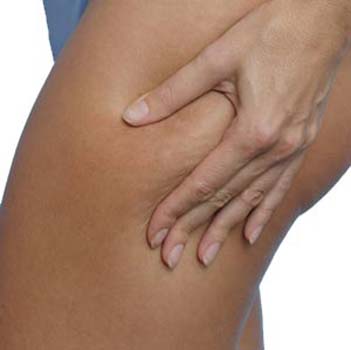Choose exercise over creams in fight against cellulite
 Munich - Cellulite is a terrible part of aging for some women. They stare into the mirror appalled when they discover the ugly dips and dents on their bottoms and thighs.
Munich - Cellulite is a terrible part of aging for some women. They stare into the mirror appalled when they discover the ugly dips and dents on their bottoms and thighs.
But young, slim women also develop the undesirable feature, which makes the skin look a bit like an orange peel. Women who get it are at the mercy of the connective tissue under their skin. There is a range of products that promise help, but experts say a healthy diet and exercise are better to counteract cellulite.
"Every woman has a predisposition for developing cellulite," said dermatologist Christoph Liebich of Munich. It's one of nature's injustices: Men generally don't get it. The reason for that lies in the structure of the female connective tissue. A woman's skin is more pliable and has more fat cells stored below it.
Aside from those differences, the collagen fibres of the female connective tissue are laid out parallel to each other and upright. In a man, they are woven in a network and slanted. Fat cells can squeeze into the collagen, creating the ugly dents on the surface. If the connective tissue gets weak while fat cells grow at the same time, cellulite is the result. There are ways to fight it.
"Lots of exercise, a proper diet that includes a lot of fruits and vegetables, carbohydrates that metabolize quickly, little fat and sufficient fluids are the most effective measures against cellulite," said dermatologist Anne Hundgeburth of Cologne, a member of Germany's professional association for dermatologists. Three goals are reached by taking these steps: Increased circulation in the connective tissue, fewer waste deposits and shrinkage of the fat cells.
"Doing sports helps to tighten the muscles underlying the tissue," Liebich said. "When everything isn't hanging down limp and untoned, the bottom and legs look a lot better."
Because basic instincts lurk in everyone and can corrupt a training programme and iron discipline when eating, the cosmetic industry tries to steer customers toward a large selection of creams and gels that are supposed to inhibit cellulite.
The palette is multifaceted: One product has caffeine and sea algae to support the microcirculation of the skin and at the same time make it firm and elastic. Another with birch bark among its ingredients is meant to counter congestion in the tissue. Other products promise to improve circulation or stop fat cells from multiplying. Some of them say they can tighten one's silhouette while sleeping.
The products are aimed generally at the same thing that is at the centre of any cellulite therapy. But experts doubt their effectiveness.
"Thus far no test has found a cream to be effective," said Hanne Vedder of Germany's consumer centre in Stuttgart. "People who believe they are getting rid of their cellulite because they are using a cream are mistaken."
Doctors point to the fact that creams, gels and oils do not penetrate deeply enough into the skin to work where cellulite is.
"If anything at all, an increase in circulation in the upper layer of skin is induced," said Hundgeburth. The active ingredients in the creams, gels and oils as a rule don't reach the fat cells below the skin.
More important than the creams themselves is the massage effect of rubbing them into the skin, said Liebich.
"A proper massage stimulates circulation and lymphatic drainage," he added. It helps carry waste products away, lowers the amount of water stored in the tissue and promotes circulation. "That's important at least to contain cellulite."
It doesn't hurt to sufficiently moisturize the skin and to use products that have active ingredients such as fruit acids or vitamin A - also called retinol, said Vedder. But this can be done without an expensive cellulite cream.
The old recommendations remain the best: drink enough liquids, massage the area, ride a bike, take the stairs, Vedder added. This doesn't completely prevent cellulite, but there is at least a chance that this will delay the development of the bothersome orange peel skin. (dpa)